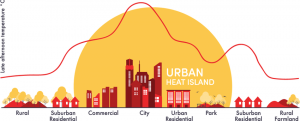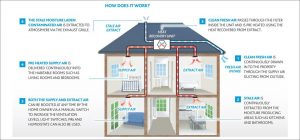This is a subject that interested us immediately. Climate change is a problem all of us will be facing very soon and as young engineers, we feel concerned. It is important for us to know what difficulties we will encounter in the future, and to get involved as early as possible to try to adapt the best we can. To help us write this article, we principally based ourselves on online articles. The subject being recent, we have found all the necessary information on these platforms.
What changes are expected
Global warming will induce a significant amount of change in our daily environment. Therefore, the environment of our homes will also be impacted. Rising global temperatures is not the only problem we will face. This increase brings with it a succession of changes which induce others. More extreme high temperature days, more weather events that are difficult to control will happen, such as storms, cyclones, rainfalls or tornadoes. This way, the climate will be hotter and wetter, so buildings will directly be affected. Apart from structural stability problems, this new hotter and wetter environment might expose our climate indoors to more bacteria or moisture, which can lead to health concerns. All these changes might become big issues to the air quality (with the increase of pollution in the air for example) or even thermal comfort (with rising temperatures).
Unstable thermal comfort
Rising temperatures due to global warming has plenty of effects, especially in cities, where a direct relevant effect is the Urban Heat Island Effect (UHIE), that shows local significant increases in temperatures. This effect is influenced by differences in soil, geographical location, relief or colors of buildings. Rising temperatures and UHIE will impact thermal comfort, especially in buildings exposed to warmer conditions than they were designed for: simulation model and HVAC equipment chosen years ago could become obsolete. In these cases, controlling indoor temperature in a few years would be laborious, and worse in case of HVAC fails during summer. Note that temperature could be more pleasant during winter. Other factors influencing thermal comfort are occupant behavior (opening window), floor level (last floor is more subject to heat), building orientation and obviously, the level of insulation. This last one is likely to evolve in lots of buildings to spare energy and limit climate impact.

Indoor air quality issues
A major potential impact of climate change is an increase in indoor contaminants and as a result, an increase in population and population range having health problems. High exposure to concentrations of air pollutants such as PM, Radon, VOC , POP and combustion products (NO2, CO) cause acute and chronic effects, such as respiratory infections, cardiovascular diseases, intoxications, headaches, nausea, eye irritations or allergies. Among the reasons of indoor air contamination, changes in building design or technology due to energy efficiency measures are an issue. New building material, such as insulation material may cause accumulation of indoor pollutants that can’t escape. Moreover, indoor sources of pollutants coming from flame retardant of fabric treatment product for strain resistance and insulation may become more significant. Again, protection against ozone offered by buildings due to filtration on internal surfaces could be affected because of new designs. Higher temperature and dryer weather conditions may lead to greater volatile POP, VOC or dust and we could face earlier appearance and longer exposure to seasonal allergens such as pollen. All of them could seep in homes by ventilation or windows. Lastly, homes tend to have a warmer and more humid environment because of climate change. Such conditions lead to dust mites, damp and mould. It can attract pests and insects that adapted to the new climate conditions. Green building material made of wood cellulose offer an environment loved by moisture, bacterial et microbial organism. All this may increase allergies on humans.
How to improve the situation?
As seen before, climate change will have an impact on indoor climate in different ways, but for most of them, many solutions exist. Therefore, a selection of solutions have been done for three different cases: the isolation, the prevention of overheating and the improvement of the indoor air quality. They all have one common point: to enhance indoor climate but with a low impact on energy consumption, in order to avoid exacerbating the effects of global warming.
Green roof to prevent overheating
It has been seen that in very dense cities, the increase of temperature could be more effective. A solution to prevent this effect is to install green spaces, and more specifically green roofs. In fact, plants absorb heat in two principal ways, one with the evaporation of moisture that they have kept, and the second with their thermal mass. This system of insulation could prevent heat transfer from the roofs, while plants purify the air thanks to their photosynthesis. Moreover, we can prevent overheating without energy waste, by installing external awnings for south and west facing windows in order to stop sunray. Lastly, replacing carpets with wooden floors or tiles to expose the cooling effect of the ground or by increasing ventilation at night could be beneficial.
Better insulation
To spare the energy needed to cool and heat buildings, the first thing to do is to have buildings with a good insulation, this way we can have a better control on indoor temperature with a minimal energy consumption. As the norms are always changing and improving, it is recommended to redo the isolation of ancient houses (<1970) and particularly the roofs that represent 25 to 30% of heat losses. The construction of low-energy houses will also improve the energy lost due to lack of insulation.
Ventilation with MVHR
Mechanical ventilation with heat recovery systems could be a solution to upgrade indoor air quality in well-isolated houses. This system could be better than natural or other mechanical ventilation, because clean hot air is supplied and up to 90% of normally wasted heat is recovered, reducing the heating requirements by 25%. Moreover, extracting warm damp air in rooms like bathrooms and kitchens, where air is more polluted, and supplying clean air in rooms where inhabitants spend the most of their time, like bedrooms and living rooms, could even improve indoor air quality. It would also be preferred if outside air is filtered in the ventilation system to prevent outdoor pollution.

To Conclude
Climate change is real, and as we said earlier, impacts are numerous and there are a lot of factors to take in account. Moreover, we can’t predict precisely what changes will really occur and where. This way, our solutions are based on assumptions. By implementing several of them, we can only attenuate the effects of climate change on indoor climate. As a result, finding an ideal solution would require in-depth studies depending on each region and its environment.
Ribeiro Paulo, Dalimier Jeanne, Felber Arnaud, Rausis Emilie
References
[1] 5 Steps to avoid complaints about MVHR and MEV noise. (s. d.). Cass Allen Associates Ltd – Independent Acoustic Consultants. https://www.cassallen.co.uk/5-steps-to-avoid-complaints-about-mvhr-and-mev-noise
[2] Are Heat Recovery and Ventilation Systems Worth It? (s. d.). https://www.bpcventilation.com/blog/are-heat-recovery-and-ventilation-systems-worth-it
[3] BABOTA, F. (2014). MECHANICAL VENTILATION SYSTEMS WITH HEAT RECOVERY FOR REFURBISHMENT PROJECTS AND NEW BUILDINGS. Technical University of Cluj-Napoca Faculty of Civil Engineering.
[4] Brennan, T. (s. d.). Indoor Environmental Quality and Climate Change. 44.
[5] Council, N. R., Medicine, I. of, & Allergens, C. on the H. E. of I. (1993). Indoor Allergens : Assessing and Controlling Adverse Health Effects. National Academies Press.
[6] Licina, D. (s. d.). Different air pollutant. Indoor climate Civil-212 EPFL.
[7] Mechanical ventilation with heat recovery | Centre for Sustainable Energy. (s. d.). https://www.cse.org.uk/advice/advice-and-support/mechanical-ventilation-with-heat-recovery
[8] MVHR : Benefits of Mechanical Ventilation with Heat Recovery. (2016, février 4). Allan Corfield Architects. https://acarchitects.biz/self-build-blog-mvhr-systems/
[9] Sailor, D. J. (2014). Risks of summertime extreme thermal conditions in buildings as a result of climate change and exacerbation of urban heat islands. Building and Environment, 78, 81‑88. https://doi.org/10.1016/j.buildenv.2014.04.012
[10] Vardoulakis, S., Dimitroulopoulou, C., Thornes, J., Lai, K.-M., Taylor, J., Myers, I., Heaviside, C., Mavrogianni, A., Shrubsole, C., Chalabi, Z., Davies, M., & Wilkinson, P. (2015). Impact of climate change on the domestic indoor environment and associated health risks in the UK. Environment International, 85, 299‑313. https://doi.org/10.1016/j.envint.2015.09.010
Figure 1. The effect of Urban Heat Island (UHI). (s. d.). ResearchGate. Consulté 24 novembre 2020, à l’adresse https://www.researchgate.net/figure/The-effect-of-Urban-Heat-Island-UHI_fig1_326316773
Figure 2. Mechanical Ventilation Heat Recovery (MVHR). (s. d.). Fervo Renewable Energy. http://fervo.co.uk/mechanical-ventilation-heat-recovery-mvhr/